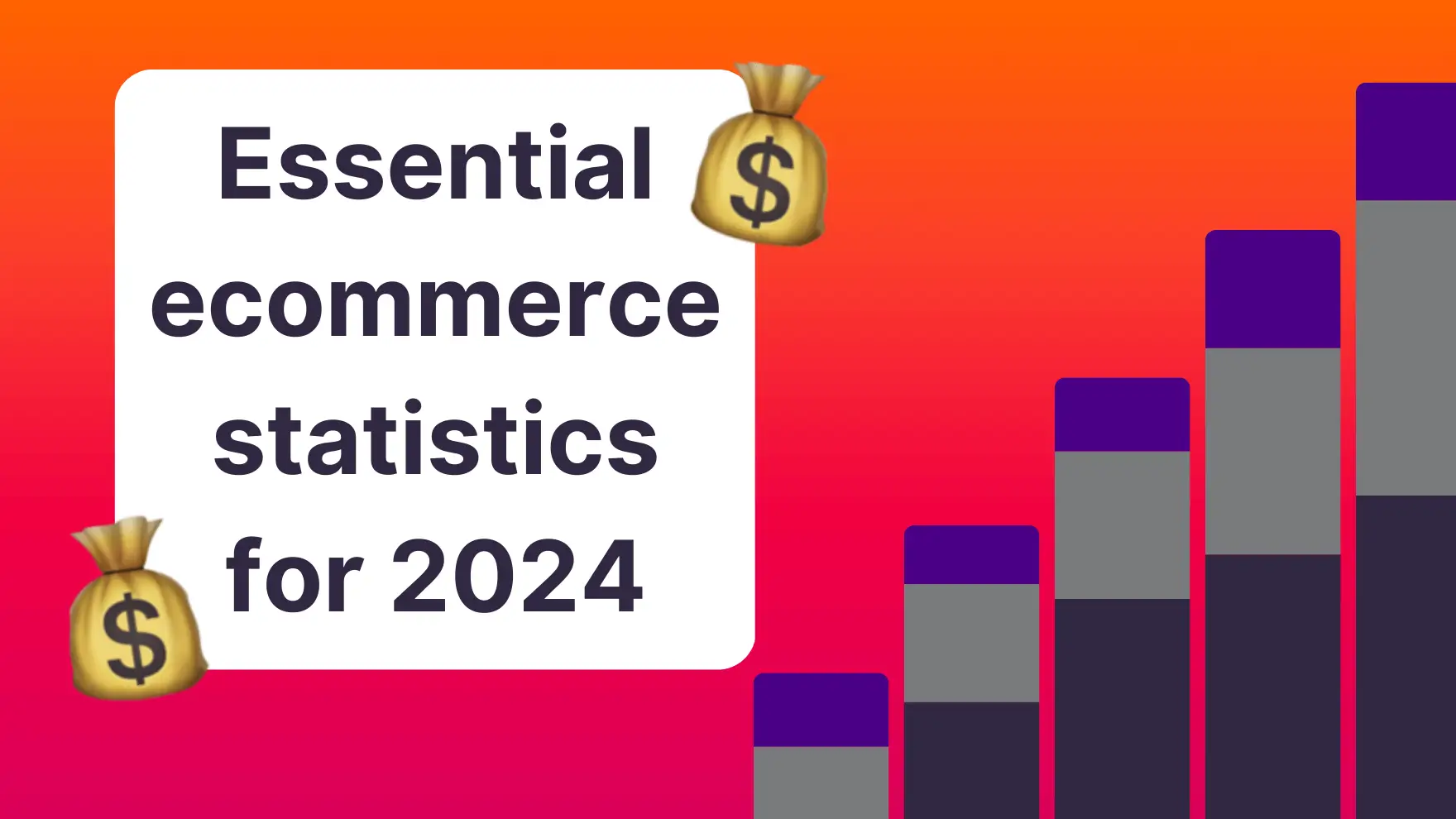Running an online store and need some input?
Aspiring entrepreneur looking to launch the next big thing?
Look no further, we’ve got just what you need.
We’ve collated some of the most recent and cutting-edge eCommerce statistics to inform your online business. From marketing considerations and shopping carts to global trends and consumer psychology, these insights will influence just about every aspect of your business.
After all, when it comes to staying ahead of the curve, nothing is more important than staying up-to-date with industry developments and trends. Making sure you know the latest statistical data is one of the best ways to predict where the market is headed and learn from how it has evolved in the past few years.
In this article, we’ll be diving into the top eCommerce statistics for 2023 and the best strategies for taking advantage of them in your business. We’ve organized everything into eight simple categories, with an Editor’s Pick to kick things off – so all the information should be nice and easy to digest too.
So without further ado, let’s get to it!
Editor’s Picks: 10 Most Interesting Ecommerce Statistics 2024
- 20% of online shoppers buy something online every week (Statista)
- 76% of consumers say they make purchases on mobile because it saves them time (Dynamic Yield)
- 66% of consumers begin their product searches on Amazon (Jungle Scout)
- On average, 52% of eCommerce sites have omnichannel capabilities (Think with Google)
- 93% of consumers make purchase decisions based on the visual appearance of an eCommerce website (Justuno)
- The highest conversion rates occur on eCommerce pages with load times between 1 and 2 seconds (Portent)
- China is currently the biggest eCommerce market in the world (Statista)
- 49% of shoppers say they use Google to discover or find a new product or item (Think with Google)
- 61% of customers would like to receive promotional emails weekly (MarketingSherpa)
- Nearly 80% of consumers make a special effort to purchase from brands whose values are closely aligned with their own (Harris Interactive)
Ecommerce Statistic

Let’s start with general ecommerce statistics to see how the industry is shaping up. These data points generally indicate there’s ample scope for businesses to grow by transitioning to online retail. If you’re considering selling your products online, these impressive stats should inspire you to take the leap!
1. It’s estimated that there will be 2.667 million digital buyers in 2023 (Statista)
This represents a 1.4% increase from last year. With the number of online shoppers growing, there’s really never been a better time to create an online store.
2. Ecommerce sales are projected to reach $6.5 trillion in 2023 (Statista)
Wowee! In other words, eCommerce is expanding and becoming a vital tool for growing revenue and sales. If you want to get a piece of this multi-trillion dollar pie, we suggest you start building an online presence so you can easily sell products worldwide.
3. 27% of total eCommerce sites use WooCommerce (BuiltWith Trends)
Second up is Shopify which is used by 20% of eCommerce sites. Both are very solid options for building a successful online presence. So if you were wondering which platform to use for creating your store, you now have two great options to pick from.
4. Amazon is expected to account for nearly 40% of eCommerce sales in 2023 (eMarketer)
After setting up your online store, you may consider adding a sales channel for Amazon so you can tap into the eCommerce giant’s massive customer base. It’s always a good tip not to rely solely on one sales channel to drive your business.
5. Digital and mobile wallets are estimated to make up 51.7% of eCommerce payments by 2024 (Statista)
Offering multiple payment options is key to providing a user-friendly customer experience, so make sure to utilize modern payment solutions such as PayPal and Apple Pay in your online store.
6. On average, 52% of eCommerce sites have omnichannel capabilities (Think with Google)
Being omnichannel means marketing your business through various platforms. For instance, you can market your products through a website, email list, Facebook Ads, and Etsy store. This strategy is tremendously powerful — and will shape the future of eCommerce.
7. Mobile eCommerce will account for 40.5% of total eCommerce sales in 2023 (eMarketer)
This means a good chunk of online shoppers will be accessing your website from their mobile devices. Fortunately, most eCommerce website themes come already optimized for mobile.
Online Marketplace Statistics
While DTC (direct-to-consumer) eCommerce has seen explosive growth in the last few years, the appeal of online marketplaces hasn’t faded. People continue to visit Amazon, Etsy, and other marketplaces because of the trustworthiness and convenience they offer.
Here are some marketplace stats you need to keep in mind as you build a sales strategy for your online business:
1. B2C marketplaces sales are estimated to hit the $3.5 trillion figure by 2024 (Digital Commerce 360)
Preferences for one-stop shopping, seamless checkout, and fast delivery are driving marketplace sales at an astonishing pace. As such, leveraging marketplace channels should be your first step towards adopting an omnichannel strategy for your store.
2. 66% of consumers begin their product searches on Amazon (Jungle Scout)
No surprises here. Amazon is the global behemoth of marketplaces and offers a huge assortment of products at competitive prices. You can tap into its massive customer base by adding an Amazon sales channel to your online store – as long as your margins are healthy enough to accomodate for the fees involved, that is.
3. Etsy had 36.3 million repeat buyers last year, a 121% increase since 2019. (Etsy)
Masses of shoppers who previously bought from Etsy came back to spend again. This indicates that selling on the Etsy marketplace could be an effective way to earn repeat customers – an interesting opportunity!
4. 34.9% of US mobile users have the eBay app installed on their device (eDesk)
Listing your products on eBay can help you get in front of mobile shoppers and ensure you benefit from the rise in m-commerce transactions.
5. More than 1 billion people globally use Facebook Marketplace to browse or purchase items (Statista)
Selling on the Facebook Marketplace can help you find customers in your community. With more and more people using the platform to buy products, you’re likely to grow your business’s local customer base. Plus, for US-based stores, Facebook offers an expanded Marketplace set-up including access to a nationwide customer base and a sophisticated on-site checkout.
6. 45% of Wish’s revenue comes from European customers (Backlinko)
Wish is an online marketplace selling anything you can imagine that’s famous for low price tags on so-called expensive products. If you’re looking to expand your business to Europe, Wish offers a quick and easy way to introduce your brand to customers there.
Shopping Cart Stats

The shopping cart is an integral aspect of a customer’s online shopping experience. It’s where they collect all the products they’re intending to purchase while browsing, and a good or bad experience here can really make or break the final sale! Below we’ve collected some interesting facts about shopping carts for you, including abandoned carts which can have a huge effect on sales.
1. An optimized checkout design can improve an eCommerce site’s conversion rate by 35.26% (Baymard Institute)
Your checkout page can make all the difference when it comes to finalizing those purchases. Make sure its design is easy on the eyes and all functionality is seamless and easy to use. Want to learn more? Check out these best practices for optimizing your checkout page.
2. The average eCommerce cart abandonment rate across all industries is 69.82% (Baymard Institute)
This means about seven out of every ten shoppers won’t complete their purchase, regardless of the industry! So simply getting your customers to put things into their cart isn’t enough, you have to persuade them to follow through.
3. Mobile users abandon their shopping carts at a high rate of 85.65% (Barilliance)
To improve mobile sales, make sure your site loads fast and displays key elements above the fold.
4. 48% of shoppers abandon their carts because of high extra costs (Baymard Institute)
Extra costs – including taxes, shipping, and fees – aren’t always indicated on a product page. Communicating these costs upfront can help shoppers decide whether or not they want to go ahead with their purchase and conveys a feeling of trust. Nobody likes to feel like they’re being taken advantage of by sneaky hidden costs!
5. Most shopping carts are abandoned on Mondays, and the least abandonments happen on Saturdays (SalesCycle)
People are usually in browsing mode during weekdays, and weekends are when they find time to narrow down their choices and make purchase decisions. Think about how you can use this fact to your advantage through targeted marketing campaigns.
6. November and December typically enjoy lower cart abandonment rates (SalesCycle)
If we’re to wager a guess, the impending holiday season might have something to do with this.
7. Cart abandonment emails have an average open rate of 45% (Moosend)
If you’re not doing it already, consider sending reminder emails to customers for their incomplete orders. Many online store builders (such as Shopify) offer abandoned cart emails as part of their functionality. You could also offer an incentive like free shipping to encourage them to purchase.
Mobile Ecommerce Stats
Mobile eCommerce, also known as m-commerce, has experienced unprecedented growth in the past several years. Shoppers are becoming accustomed to using their devices to research products and services before the actual purchase. That’s why it’s critical to ensure your website is fully optimized for mobile experiences. Below are the most interesting trends and facts to help you capitalize on the power of m-commerce.
1. Retail m-commerce sales are projected to reach $728.28 billion and account for 44.2% of US ecommerce sales by 2025 (Insider Intelligence)
In other words, nearly 2 out of 4 dollars spent on online purchases in 2025 will be on a mobile device. That’s huge!
2. 76% of consumers say they make purchases on mobile because it saves them time (Dynamic Yield)
With the ability to browse, compare, and purchase on the go, consumers find it more convenient to shop online on their mobile devices.
3. Nearly 50% of consumers buy more on mobile than in-store (Ibotta)
Whether you’re selling products online or in-store, offering a mobile shopping experience is key to boosting your revenue and profit.
4. The mobile payment market is projected to reach $4.574 billion by 2023 (Retail Customer Experience)
Offering payment via mobile wallets such as Apple Pay and Google Pay can help you convert shoppers at checkout. These payment methods eliminate the need to enter credit card details but are still secure and convenient to use for online purchases.
5. 90% of shoppers believe that mobile eCommerce experiences can be improved (Dynamic Yield)
Impress shoppers by simplifying your mobile site’s navigation and making content easy to browse on the small screen.
6. Consumers prefer dedicated mobile apps for doing online shopping, which accounts for 54% of overall mobile commerce payments (JP Morgan)
While creating a dedicated mobile app is a big investment, it can definitely help bring your sales to the next level. It’ll give you a better chance of standing out in the marketplace.
Online Shopping Stats

More people than ever are shopping online. Today, a growing segment of the population prefers to shop online rather than visit brick-and-mortar stores. The following are some of the most pertinent statistics related to online shoppers and their behavior.
1. 20% of online shoppers buy something online every week (Statista)
This means 1 in 5 eCommerce customers make 4 online purchases per month. Another segment of customers, 31%, buys online at least once per month.
2. The average online shopper spends $2.50 USD across all verticals (Statista)
The average online cart is worth less than a frozen pizza, pushing online stores to consider new methods of increasing cart value.
3. 88% of shoppers read 3+ reviews before purchasing online products (Digital)
It’s critical to obtain as many online reviews as possible for your brand and its products. Too few, and consumers may find your brand less trustworthy and won’t want to purchase from you.
4. As of February 2022, the average conversion rate across all verticals was 1.53% (IRP)
This has dropped by 0.32% since 2021 and 0.17% since January 2022. This means an average of only 1.53% of people visiting a store will end up buying something there, meaning you have to work even harder at optimizing your website and user experience.
5. The global same-day delivery services market will reach $6.43 billion in 2023 (The Business Research Company)
There is a sizable appetite for same-day shipping for online customers in the United States and beyond. People want things, and they want them NOW.
6. In 2023, 76% of consumers expect free two-day shipping with a $40 purchase (Fabric)
People are used to being offered free shipping left right and center these days, so be sure to take that into account when you’re pricing your products.
7. 79% of customers believe that sustainability is important when shopping for apparel (CGS)
Since fashion is currently the largest market segment for eCommerce but also has a bad reputation for an overabundance of ‘fast fashion’ (i.e. throw-away, low quality items), niche-ing into sustainable products could be an enormous opportunity here.
Global Ecommerce Trends
As the world changes, so does eCommerce. New technologies and platforms help startups get off the ground, while a growing number of global buyers are pushing the industry toward certain industry verticals. Here are a few poignant statistics related to the eCommerce market on a global scale.
1. In 2025, global retail eCommerce sales will amount to USD $7.4 trillion (Statista)
In 2021, this number was just USD $4.9 trillion.
2. Brazil is experiencing the largest volume of eCommerce sales development, growing 20.73% from 2023 to 2025 (Statista)
Expanding your online store to international locations can be a great way to scale your b business – particularly Brazil, Argentina, Turkey, India, and South Africa, have been showing a big boost in recent sales.
3. China is currently the biggest eCommerce market in the world (Statista)
The country currently accounts for 46.3% of all eCommerce sales worldwide.
4. 94.4% of the South Korean population will shop online by 2023 (Stanbic)
South Korea presents a massive opportunity for eCommerce merchants looking to sell beyond their borders.
5. There are more than 2.14 billion eCommerce shoppers worldwide (Statista)
This has nearly doubled since 2016 and is set to double again by 2030.
6. The global cross-border eCommerce market will exceed $2.2 trillion by 2026 (Statista)
If your online store isn’t open to global buyers, you could be missing out on hundreds of potential sales!
7. Fashion will be the largest segment of the 2023 global eCommerce market (Statista)
Businesses in the fashion, apparel, and footwear industries continue to be on a winning streak in 2023.
Ecommerce Marketing Statistics
Every online merchant wants to increase traffic and conversions. However, deciding where to allocate your marketing budget is no easy task. Below, we look at the latest eCommerce marketing statistics and which channels are attracting the most interest amongst eCommerce marketers and advertisers.
1. 61% of customers would like to receive promotional emails weekly, and 38% want brands to email them promotions even more frequently (MarketingSherpa)
This indicates that shoppers are more receptive to email campaigns than most marketers think. Using email marketing can be an effective way to build awareness for your products and brand, as well as drive conversions.
2. 40% of people had purchased something online after seeing it being used by an influencer on Twitter, YouTube, or Instagram (Influencer Orchestration Network)
Influencer marketing engages a broader audience and fuels word-of-mouth – which is huge in the age of reviews and testimonials. Consider partnering with micro or nano- influencers in your industry to drive sales for your products.
3. 38% of consumers are more likely to purchase from a business that offers live chat (Kayako)
Customer service is the key to a positive customer experience! M people look for an immediate response from brands on product or sales questions. Thankfully, most eCommerce platforms seamlessly integrate live chat software, allowing merchants to cater to visitors in real-time.
4. 49% of shoppers say they use Google to discover or find a new product or item (Think with Google)
When it comes to getting your products in front of potential buyers, don’t forget the power of search engine optimization (SEO).
5. US social commerce sales are projected to reach $45.74 billion in 2023, with more than 50% of the country’s shoppers making a purchase on social media (Insider Intelligence)
Whether it’s TikTok, Instagram, Facebook or Pinterest, leveraging social media channels is essential for generating leads and sales for your business.
6. Almost 89% of consumers (nine out of 10 people) worldwide make an effort to read product reviews before making purchases (Oberlo)
To capitalize on this trend, make sure to display customer reviews on your product pages. Also, seek additional ways to create user-generated content – it’s a great way to build social proof, which helps foster trust in your brand.
Consumer Psychology Statistics

Being clued up on consumer psychology is critical in today’s cutthroat eCommerce environment. After all, online shoppers prefer to engage with brands that personalize the customer experience. Below are a few stats to help you understand what buyers actually care about and how you can use psychological triggers to turn shoppers into loyal customers.
1. 93% of consumers make purchase decisions based on the visual appearance of an eCommerce website (Justuno)
From your website theme to your product images, your store’s visual appearance plays a major role in influencing whether your visitors will end up completing a purchase or not.
2. The highest conversion rates occur on eCommerce pages with load times between 1 and 2 seconds (Portent)
Nobody likes to wait! When shoppers find what they’re looking for and fast, the majority of them feel confident clicking through the checkout flow to the end.
3. 51% of US consumers are compelled to make a purchase when they receive a deal (Jungle Scout)
Who can resist the draw of a good deal to save some money? It’s a powerful buying motivation not to be sniffed at!
4. 48% of consumers revealed consistently lower prices are the key reason why they shop with their favorite brands (Jungle Scout)
The premise is simple: people will commit to brands that make continuous efforts to keep their offerings affordable. With rising inflation impacting spending habits, affordability will drive brand preferences this year and beyond.
5. Nearly 80% of consumers make a special effort to purchase from brands whose values are closely aligned to their own (Harris Interactive)
As a brand, you should seek to understand what really matters to your audience and align your values with their needs. This will help you really land within your niche and target audience.
6. 48% of shoppers would buy from online retailers that offer hassle-free returns (BargainFox)
The post-purchase customer experience carries more weight than ever. It’s obvious really: with online purchases, things simply don’t always turn out exactly as you imagined. So the returns process needs to be straightforward and hassle-free, or else you risk never having that customer return again.
Looking Ahead
The last few years have been a bit of a drag for the world, let’s be honest. But on the bright side, the eCommerce industry has accelerated to unprecedented levels – and plenty of entrepreneurs like you have been able to reap the rewards from it too. While that’s exactly what we like to hear, it’s now more important than ever to keep an eye on industry trends and developments, as things keep evolving and the world finds its new normal. Knowing what your customers want and need should always be at the top of the list when it comes to optimizing your business. This is what will set you apart from the crowd and make your business truly future-proof. We hope this article has helped you along the way to that goal! Are there any other interesting stats you’ve come across of late? Let us know in the comments below! And as always, if you have any questions or want to talk about anything eCommerce related, don’t hesitate to reach out to our customer support team.
I’m telling you about this, because I believe in giving information regarding PPC advertising
forward,
I don’t know how much longer people accepting new technology , so you had better check it out now if you can.
Just click the link below to get started:
Discover more from Personal Blog of Richard Tong
Subscribe to get the latest posts sent to your email.





GET CASH BACK ON GAS & FOOD PURCHASES ———> Free App!
Thanks for sharing your thoughts on off. Regards
past, but we have heard of a lot advantages you would like to have. clenbuterol
Thaqnks for sharing your thoughts about daftzr judi slot onlineterpercaya. Regards
Thanks for sharing your thoughts on essay for me. Regards
Thanks designed for sharing such a good thought, piece of writing isfastidious, thats why i have read it entirely
Fantastic blog. Really Great.
Appreciate you sharing, great blog article. Will read on…
Im thankful for the blog post. Much obliged.
Appreciate you sharing, great article. Keep writing.
Very good blog.Thanks Again. Really Great.
I am so grateful for your blog post.Much thanks again. Really Great.
Really enjoyed this blog post. Keep writing.
The most effective and clear News and why it means quite a bit.